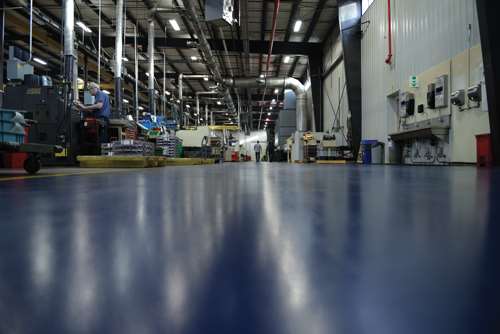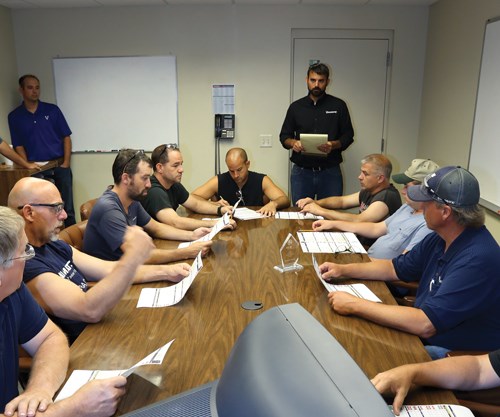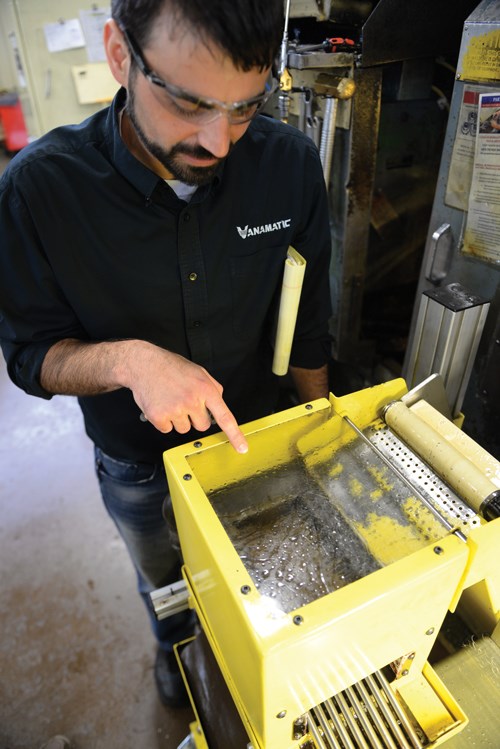Moving Forward with Self-Directed Work Teams
We all deal with change in different ways. It’s critical to first, recognize, and next, do something constructive about it. The Ohio shop is well on its way on both fronts.
The precision machined parts industry continues to evolve with the ability to add additional operations to its traditional turning-based part processing. Milling departments, grinding departments, EDM and other machining operations are finding their way into shops that are historically screw machine based.
Machining centers, often used for secondary work, are increasingly being applied to primary operations. However, it’s important to have the internal shop structures in place as different operations are added to the production mix.
Featured Content
These changes seem to be a natural progression as customers demand more from their suppliers. Shops, in turn, are reconfiguring themselves to provide these additional operations.
We’ve all seen cam-actuated machine tools being augmented by CNC. In many shops, these two technologies exist side by side with cam-making areas of the shop, adding programming capabilities to run the CNC machines for turning, milling and multitasking operations. Providing these additional metalworking capabilities increases the ability and flexibility to do more work for a given customer mix.
As traditional screw machine shops wrestle with the “make or buy” decision regarding implementing non-traditional machining operations, most shops have at least begun the process. Beyond the technical training needed to learn how to operate different equipment, process control and shop management are also key factors in successfully integrating new operations.
One shop making a concerted effort in this new direction is Vanamatic Company, in Delphos, Ohio. With more than 60 years in the precision machined parts business, this company has seen and dealt with a lot of changes.
Currently, the Vanamatic team is building on that experience to help move the fourth generation family business into the 21st century. However, the approach it is currently taking is less about cutting chips (it has those processes down pretty well) and more about integrating customized ERP-based techniques to help better manage the business through employee empowerment, accountability and clear, two-way communication channels.
Adam Wiltsie, the company’s plant manager, says, “Our people know how to make parts. As managers, we need to provide the tools, information and assignments so we have ‘the right people, making the right decisions, at the right time,’ which is our corporate philosophy.”
The work that Vanamatic’s management has done over the past few years has resulted in better communication with employees, which frees them to do the jobs they know how to do. The successful result has allowed management to move forward by creating and implementing communication tools necessary to use self-directed work teams.
The Right People
More than 10 years ago, the shop recognized the changing nature of its business. Historically, a multi-spindle screw machine shop, it made the decision to move from its traditional linear production system and implement a more flexible, cellular-based production system.
The change affected the employees who were basically one man operating one or two machines to a team-oriented approach that better fit the cellular system. The shop came across a behavioral assessment program that was presented at a PMPA (Precision Machined Products Association) meeting (Vanamatic has been a member since 1957). Using behavioral assessment helped recognize various learning patterns in individuals. Taking those into account when forming teams was important to creating a successful chemistry among the teams.
Using the team-based model in a cellular manufacturing system has broken down some of the silos that tended to exist before. “Historically, our people were somewhat vertically integrated based on the job they did,” Mr. Wiltsie says. “Cells changed that by inviting cross-training and making the job less individual focused and more team-oriented and adding more variety to the work.”
An improvement in change-over times for the shop’s multi-spindle machines is an example of the company’s success using the team-based model. When Vanamatic started its setup reduction program, the average change-over time was in the 17-hour range for these machines. That resulted in about 300 setups per year. Last year, using the team approach, the average time was 3.5 hours, which allowed almost 1,000 setups—a significant improvement.
With the implementation of team-based operations backed by access to relevant information, the “right people” part of the shop’s philosophy is in place. It’s working, too. The average tenure for the 82 employees at Vanamatic is more than 14 and a half years. It’s a critical function for shop management to keep good people engaged in the business. They are simply too hard to find in today’s environment.
Making the Right Decisions
All customer releases are housed in Vanamatic’s ERP system. Every customer part is 3D modeled and verified using the company’s advanced engineering system and stored in the ERP system. The trick, according to Mr. Wiltsie, is getting the information to the shop floor in a format that presents the work to be done in a crystal clear way.
Teamwork only works if the team knows what to work on. To accomplish this, Vanamatic has developed what it calls information automation through an internally developed “easy button.”
It can analyze thousands of customer releases in seconds. According to Mr. Wiltsie, “Most shops already have the software to create its own easy button—it’s Excel Macros, which is how we output the data housed in our ERP system to communicate production orders, status and other pertinent information with the shop.
“Moreover,” he continues, “the information is updated every 30 minutes, including every shipment made, every inventory transaction, production rates, efficiency, tool cost and material on hand. With a computer available at every machine in the shop, the information is available to anyone in the shop with a couple of computer clicks. It’s one way the teams keep score and understand what needs to get done and when.”
Using an internally developed program called “SPEED” (single point entry of engineering data), the shop floor is informed of all necessary instructions for a given job. Setup, tooling, bill of materials and inspection instructions reside on the system and are accessed through the shopfloor computer terminal.
The tool room and secondary operation stations are also linked together using this shop-wide paperless system. Each cell is equipped with measurement and inspection tools, so quality control is done at the cell level.
Since self-direction at the shopfloor level is a goal, having the necessary information available and easily accessible becomes a critical component for making that happen. Giving the cells access to the customer order pipeline, delivery dates and part production information enables them to better plan and sequence the work assigned to them, which in turn, results in more efficient production.
At the Right Time
Every day, a progress report is generated and reviewed in what is called a daily huddle. Representatives of each cell meet to discuss where various jobs stand relative to promised delivery dates.
The information is provided on an excel spreadsheet, which contains a shop-wide progress report on work-in-process through the shop. Each team cell is represented on the report and the jobs assigned are in percentages of actual production versus the production plan.
During our visit to Vanamatic, which was on a Monday, the percentages were relatively low, however, looking at the previous weeks’ totals, the work was done on time. Having a window on daily production allows for adjustments to be made up or down as business conditions change (for example, hot jobs).
The cell team huddle is followed by a daily office huddle where department heads discuss order status and plan for business conditions ongoing and analyze the reports from the shopfloor huddle. These daily huddles are relatively short with each participant reporting. It is a practical means of communication that flows both ways.
Communication is a key factor to Vanamatic’s success. In addition to the daily huddles, the shop holds meetings weekly for all personnel, and management conducts an annual review with each employee.
The annual review is called “Start, Stop, Improve” and gives the employee an opportunity to discuss things the company should consider starting, what they should stop doing and/or ways to improve what is being done. There is little or no excuse not to have one’s voice heard or know what’s going on in the shop. Keeping the communication loop open may help explain why people stay with this company for so long.
Flex Time
Part of the self-directed team approach at Vanamatic includes the ability for employees to flex their time. According to Mr. Wiltsie, “Individuals have a window of weekly hours that runs from a minimum of 40 hours to a maximum of 48. Within that window, they can flex their time however they choose to get the job done. One employee comes into work each day for 2 hours, then goes home to fix breakfast for his kids and returns to work for the rest of the day. Flex time is a very popular perk.
“As most shops know, workload fluctuates in a manufacturing business,” he continues. “Customer demand can vary plus/minus 15 percent, which has driven us to manage in a more flexible style that better reflects these variations. Flex time has guidelines that the employees must follow, but for the most part, our people simply appreciate the efforts at latitude that we have in place, and through the communication processes in place, they understand the business cycles.”
Moving Forward
The work that Vanamatic has done to train, involve and empower its people creates a solid foundation for reacting to changes in production methods and incorporating new technologies. As the shop has expanded its operations into other areas the shop-wide systems that it has put in place to communicate cost, quality and delivery easily migrate to any new technology that customer demand requires.
With the management tools in place and employee involvement in the business, additional new operations simply require technical training to run the equipment, which is usually supplied by the builder. What seems to be an enlightened view at Vanamatic is an integral role played by its people in getting the job done right and on time.
It’s a view that has sustained this business for 60 years and will keep it moving forward for another 60 years. Moreover, it’s a business model that is transferable to other companies.
Most of the tools developed to manage the shop and communicate with the employees are developed in-house, using commercial products such as Henning Industrial Software and then customizing it for Vanamatic’s specific needs.
Likewise on the shop floor, the company makes many automation devices to speed production and lower costs. They are custom solutions to common problems, many of which come to the surface in “Start, Stop, Improve” reviews.
RELATED CONTENT
-
Automatically Optimize Your CNC Machining Feed Rates
New feed-rate-optimization technology can enable CAM programmers to reduce cycle times and increase tool life for milling and turning operations.
-
Selecting A VMC: Factors To Consider
A three-, four- or five-axis vertical machining center can run the gamut of capability and cost. Assessing your application requirements now and in the future can make for a much wiser machining center purchase.
-
Are Bar Fed Machining Centers the Next Big Thing?
Advanced mill-turn machines with bar fed material handling can overcome several inherent weaknesses of production machining on vertical machining centers.










